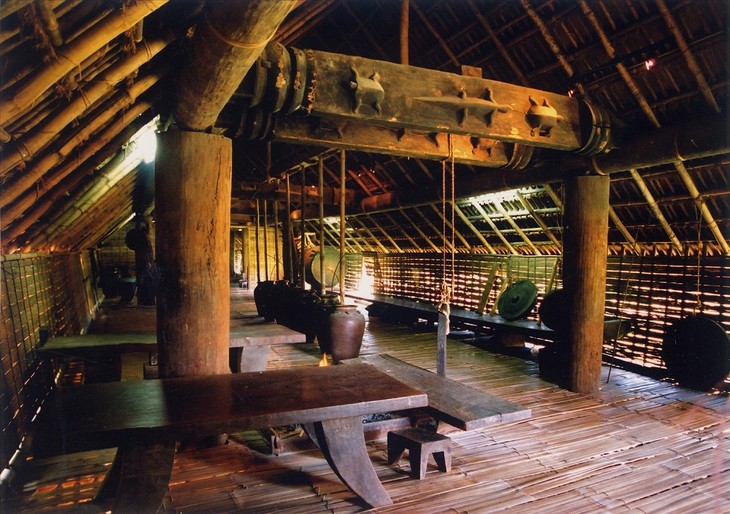
A longhouse of the M'nong at the Museum of Ethnology in Ha Noi. (Photo: dantochoc.vn)
Many ethnic groups in the Central Highlands, such as the Bana, the Jarai, and the Xơ Đăng, live in tall Rong houses. The Ede and M’nong live in longhouses, which may stretch to more than a hundred meters. The wealthier the family, the longer the house. When a family member gets married, a new compartment is added to extend the house. Year after year the longhouse grows longer.
Dang Nang Long, a M’nong man who lives in Lak district, Dak Lak province, said of the architecture: “The horizontal and vertical beams simply overlap each other. They’re not mortised and joined as they are in the wooden houses of other ethnic groups. If we want to relocate a house, we just disassemble it and then reassemble it in another place.”
A longhouse of the Ede and M'nong has two sets of entry stairs – the male stairs and the female stairs. The female stairs are at the front of the house for the use of guests and men. The male stairs are at the back of the house for the use of women.
At the front of the house is a shared space called front yard. The longer the house, the larger the front yard is. From the front yard, you will enter the most important space of the house, which is the meeting hall (Gah).
Gah is for all family members, where guests are received and worship rituals and ceremonies are held. In this meeting hall, vases of liquor and worship items such as bamboo Neu poles are stored. All Ede and M'nong ceremonial activities like weddings, funerals, and communal celebrations take place here, and the participants always drink liquor.

Inside the longhouse of the Ede (photo: dantochoc.vn)
Artisan Y Mang of Cu M'gar district, said: “We hold all our ceremonies in the meeting hall. Only the burial ceremony is held outside. We plant a bamboo Neu tree in the meeting hall and the ceremony is usually completed in one day, during which the participants eat a meal, sing, and dance together.”
On the right side of the meeting hall is a long chair in the shape of a boat where gong players sit with their backs toward the west and their faces looking eastward.
“The long wooden chair is called a Kpan. At ceremonies, people playing gongs sit along the righthand wall. There are 10 gong players and one drummer.”
In a longhouse, there are designated chairs for the host and the guests. In the center of the room is a fireplace, around which people sit on mats for ceremonies or family get-togethers to listen to epics or sing folk songs.
Y Mang told us “With people gathered around the fireplace, the patriarch tells stories and epics and teaches the children etiquette and which seat is assigned to each person in the longhouse.”
The Ede and M'nong people are very hospitable. The main fireplace in the house always has a fire and food and drinks are always made available to guests. The Ede’s cooking fireplace is rectangular or square and has a thick foundation of compressed earth to prevent the fire from burning the floor. This is where the family gathers every day to eat meals, share their joys and sorrows, and discuss family business.
Artisan H'Hoa Ni-a Kaso of Cu M'Gar district, Dak Lak province, says Ede people believe that fire is the god of luck. As long as the fireplace is burning, the family will always be warm and happy and the village will be peaceful and prosperous.
“The fireplace must always have hot charcoals, which has the power to protect the family. The fire symbolizes power that never brings bad luck to the family. The fire must always be maintained to guarantee a good life,” said H'Hoa.
In each house, gongs are always hung in the most prominent position. The longhouses of the Ede and M’nong appear in epics, folk tales, music, and paintings and are an indispensable part of the cultural identity of the Central Highlanders.
Hai Phong